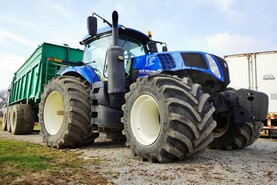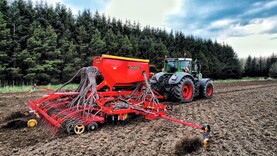With the harvest underway in many areas, the attention is now turning towards stubble cultivations. Stubble cultivation is an important management tool and an essential element of integrated pest management (IPM). It can be the precursor to minimum tillage establishment of cover crops or commercial crops in autumn. However, a one-size-fits-all approach to stubble cultivation may be counterproductive and you may not achieve your desired results. Before you start, you must decide why you are cultivating.
Poor residue management can give rise to problems, which can be hidden underground, as anaerobic decomposition of residue can reduce crop performance.

Poor residue management can give rise to a number of problems.
Residue can also cause mechanical issues such as wrapping around tines, discs or ploughs. Shallow incorporation is a useful way of dealing with excessive crop residue, but it needs to be done early.
Method: Using a cultivator (discs, tines, etc), shallow incorporate the residue into the upper aerobic layer of soil (top 5cm to 8cm). Consolidation will improve soil-to-straw contact to begin degradation in the presence of both moisture and air. Cultivation will also help to break up the lengths of straw to increase breakdown.
However, rapid degradation will be influenced by the presence and number of appropriate soil organisms and these can take a few years to establish.
Some growers take the opportunity to deep cultivate to try to alleviate compaction in the 25cm cultivation zone and deeper. This is also done to level ruts and loosen tramlines.
Soil conditions must be dry to achieve a “shattering” effect in the plough/cultivation zone, or else you risk smearing the soil and making the problem worse. As high-horsepower machinery is required for this job, care should be taken to ensure that equipment, tyres and pressure are correct, to avoid causing further compaction.
Method: Here, growers use a dual cultivator with front discs to mulch the top 8cm, followed by tines, which can work down as deep as 30cm to break up plough pans/compaction layers.
Slug and leather-jacket control
Stubble cultivation is an important cultural method (IPM) for soil pest control, and this can be very cost-effective when the desired results are achieved. Stubble and straw residues help to retain moisture, providing a favourable breeding ground for pest eggs such as slugs.

Growers are now turning their attention to stubble cultivations.
Shallow cultivation unearths the eggs from their sheltered sites and exposes them to predators. If the loosened soil is placed in little ridges where it can dry out, it will also help to desiccate the eggs and reduce pest populations over time.
Method: Using discs or a straw harrow, cultivate the surface down to 5cm. Aim for a ridged finish after cultivation to help soil drying and egg desiccation. Do not roll post-cultivation – wait for a few days after the soil has dried out.
Stubble cultivation to create a stale seedbed for the control of weeds and volunteers has become a more common IPM element for growers.
Shallow cultivation immediately after harvest helps to stimulate weed seed germination and exposure to light helps to encourage many dormant seeds to germinate.
Method: Use an appropriate cultivator such as discs, shallow cultivate to 5cm. Research shows that cultivating deeper than this can reduce weed seed germination and induce dormancy. Once germinated, the weeds can be treated with a non-selective herbicide or ploughed down. However, not all weed seeds should be treated the same. Different seeds require different conditions to germinate, as outlined below.
Sterile and great brome: These weed seeds have poor natural dormancy and can be cultivated immediately post-harvest. Ideally, consolidate to maximise seed-to-soil contact.Meadow, soft and rye brome: Seeds of these weeds need to be left on the surface for four to six weeks, in order to break dormancy before cultivation. Cereal volunteers: Cereal volunteers can be cultivated immediately post-harvest.Wild oats: Similar to some brome species, spring wild oat (most common type of wild oat in Ireland) seeds should be left on the surface for as long as possible in the autumn, to allow the seed to ripen and germinate.Blackgrass: Around 80% of seed germination occurs from August to October, so autumn-stale seedbeds are very effective. Shallow cultivations (up to 5cm) after harvest can improve seed-to-soil contact and increase germination. Oilseed rape: Seed losses at harvest should be left on the soil surface for four to six weeks, to allow for germination before cultivation. However, be mindful that delaying cultivations could increase slug numbers.
With the harvest underway in many areas, the attention is now turning towards stubble cultivations. Stubble cultivation is an important management tool and an essential element of integrated pest management (IPM). It can be the precursor to minimum tillage establishment of cover crops or commercial crops in autumn. However, a one-size-fits-all approach to stubble cultivation may be counterproductive and you may not achieve your desired results. Before you start, you must decide why you are cultivating.
Poor residue management can give rise to problems, which can be hidden underground, as anaerobic decomposition of residue can reduce crop performance.

Poor residue management can give rise to a number of problems.
Residue can also cause mechanical issues such as wrapping around tines, discs or ploughs. Shallow incorporation is a useful way of dealing with excessive crop residue, but it needs to be done early.
Method: Using a cultivator (discs, tines, etc), shallow incorporate the residue into the upper aerobic layer of soil (top 5cm to 8cm). Consolidation will improve soil-to-straw contact to begin degradation in the presence of both moisture and air. Cultivation will also help to break up the lengths of straw to increase breakdown.
However, rapid degradation will be influenced by the presence and number of appropriate soil organisms and these can take a few years to establish.
Some growers take the opportunity to deep cultivate to try to alleviate compaction in the 25cm cultivation zone and deeper. This is also done to level ruts and loosen tramlines.
Soil conditions must be dry to achieve a “shattering” effect in the plough/cultivation zone, or else you risk smearing the soil and making the problem worse. As high-horsepower machinery is required for this job, care should be taken to ensure that equipment, tyres and pressure are correct, to avoid causing further compaction.
Method: Here, growers use a dual cultivator with front discs to mulch the top 8cm, followed by tines, which can work down as deep as 30cm to break up plough pans/compaction layers.
Slug and leather-jacket control
Stubble cultivation is an important cultural method (IPM) for soil pest control, and this can be very cost-effective when the desired results are achieved. Stubble and straw residues help to retain moisture, providing a favourable breeding ground for pest eggs such as slugs.

Growers are now turning their attention to stubble cultivations.
Shallow cultivation unearths the eggs from their sheltered sites and exposes them to predators. If the loosened soil is placed in little ridges where it can dry out, it will also help to desiccate the eggs and reduce pest populations over time.
Method: Using discs or a straw harrow, cultivate the surface down to 5cm. Aim for a ridged finish after cultivation to help soil drying and egg desiccation. Do not roll post-cultivation – wait for a few days after the soil has dried out.
Stubble cultivation to create a stale seedbed for the control of weeds and volunteers has become a more common IPM element for growers.
Shallow cultivation immediately after harvest helps to stimulate weed seed germination and exposure to light helps to encourage many dormant seeds to germinate.
Method: Use an appropriate cultivator such as discs, shallow cultivate to 5cm. Research shows that cultivating deeper than this can reduce weed seed germination and induce dormancy. Once germinated, the weeds can be treated with a non-selective herbicide or ploughed down. However, not all weed seeds should be treated the same. Different seeds require different conditions to germinate, as outlined below.
Sterile and great brome: These weed seeds have poor natural dormancy and can be cultivated immediately post-harvest. Ideally, consolidate to maximise seed-to-soil contact.Meadow, soft and rye brome: Seeds of these weeds need to be left on the surface for four to six weeks, in order to break dormancy before cultivation. Cereal volunteers: Cereal volunteers can be cultivated immediately post-harvest.Wild oats: Similar to some brome species, spring wild oat (most common type of wild oat in Ireland) seeds should be left on the surface for as long as possible in the autumn, to allow the seed to ripen and germinate.Blackgrass: Around 80% of seed germination occurs from August to October, so autumn-stale seedbeds are very effective. Shallow cultivations (up to 5cm) after harvest can improve seed-to-soil contact and increase germination. Oilseed rape: Seed losses at harvest should be left on the soil surface for four to six weeks, to allow for germination before cultivation. However, be mindful that delaying cultivations could increase slug numbers. 







 This is a subscriber-only article
This is a subscriber-only article










SHARING OPTIONS: